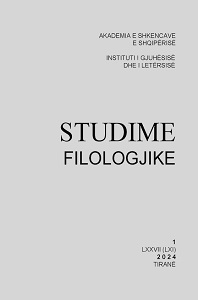Metafora në konstruktet e strukturës argumentore në gjuhën shqipe
Metaphors in Argument Structure Constructions in Albanian
Author(s): Anila KananajSubject(s): Language studies, Syntax, Semantics, Stylistics
Published by: Qendra e Studimeve Albanologjike
Keywords: conceptual metaphor; construct; argumentative structure; domain; autonomy; addiction;
Summary/Abstract: Metaphorical language makes up the majority of human discourse. Research on metaphor as a cognitive tool for conceptualizing physical and abstract occurrences is one of the most popular areas of study in modern linguistics. Albanian linguistics studies metaphor as a literary device and mechanism that creates new meanings for words. Nonetheless, research on its function in the sentence's grammatical structure has been one of the least explored topics in world linguistics up until recently, which partially explains why there aren't many studies on this topic in Albanian, and even fewer using the cognitive approach. By concentrating on the examination of the emergence of metaphor in four different types of Albanian argument structure constructs, this research seeks to close this gap in some way. The metaphorical constructions were extracted and categorized based on the semantic-syntactic characteristics they displayed from Fjalor i gjuhës shqipe (1980) [Dictionary of Modern Albanian Language]. By applying an integrated approach of the theories of cognitive linguistics, constructivist linguistics, the theory of conceptual metaphor, and Frame Semantics, the theoretical analysis expands upon the successes of metaphor studies in Albanian linguistics. The most common types of argument structure constructs in Albanian are the following: intransitive constructions with one argument (the subject), transitive constructions with an internal argument (the direct object), ditransitive constructs (an accusative object and a dative object), and passive constructions with the external argument. The old linguistic metaphors from the Dictionary of Today's Albanian Language (1980) were divided into four different types according to the features of the argument structure constructs. In general, it follows that the syntactically dependent argument is conceptually autonomous. This also explains the discussions in Albanian linguistics regarding the role of the right adverb, whether it should be taken as the main syntactic element, just like the subject, or should be treated simply as a dependent construction. Unlike the traditional approach that sees metaphor only as the transfer of meaning from the word in question, the cognitive approach implemented in this study sees metaphor as a construct. The metaphorical construct is the result of the interaction of the source domain and the target domain of the metaphor. Metaphor expresses a proposition at the level of the deep cognitive structure and has a concrete projection on the surface structure. The metaphorical construct retains the syntactic features of the source construct. Also, the semantic role is transferred from the autonomous argument in the source domain to the autonomous argument in the destination domain. The emergence of metaphors in active constructs that have only the external argument shows great similarities with their creation in non-active constructs that also have only the external argument. This is understandable since both constructs have only one argument and this is definitely autonomous. It is precisely this link between autonomous argument that evokes the metaphor in the final construct. In ditransitive constructs the appearance is not uniform, they show semantic variety. The most typical conceptual relations are the subject – neutral, the verb – dependent and the direct object – autonomous, such as the example of 'He hunts the occasion.' which has as its source domain 'He hunts birds.' Internal arguments birds – occasion form the minimal pair that evoke the metaphorical domain, features that are necessary to understand the metaphorical construct without the need for additional context. Conceptual relationships in metaphorical constructs in argument structure with a predicate and a dative complement are also diverse in Albanian. The most typical case is subject – neutral, verb – dependent, accusative complete – autonomous, dative complete – autonomous, such as the case of 'He put the blame on her.', where the minimal pairs that evoke the metaphorical construct are mud – guilt and the wall - to her. In conclusion, the integrated semantic-syntactic cognitive approach manages not only to bring innovation in theoretical and applied linguistics in relation to metaphorical constructs in Albanian, but through it can also explain a theoretical paradox that traditional syntax has not yet been able to convincingly argue. The study proves that the isolated analysis of the phrases of the sentence/utterance and the traditional theories cannot satisfactorily explain the linguistic facts of Albanian. The progress in the investigation of the phenomena in the construct, i.e. in a semantic-grammatical-phonetic-pragmatic whole, gives deeper and more harmonious results. The study presented here provides the theoretical apparatus and the appropriate methodology for the way of teaching Albanian as a mother tongue at school or as a second language. Cognitive linguistics offers an attractive and interesting tool for the learner, student, teacher, etc., which gives concrete, safe and predictable results.
Journal: Studime Filologjike
- Issue Year: 2024
- Issue No: 01
- Page Range: 65-87
- Page Count: 23
- Language: Albanian

